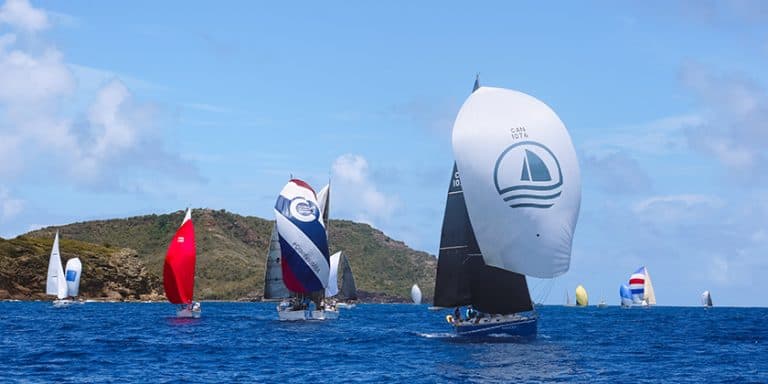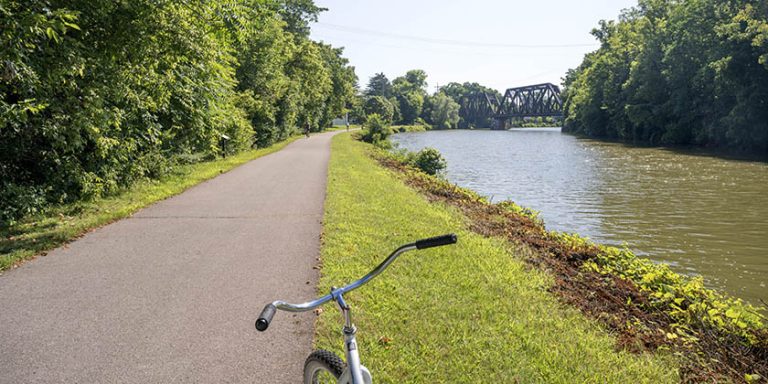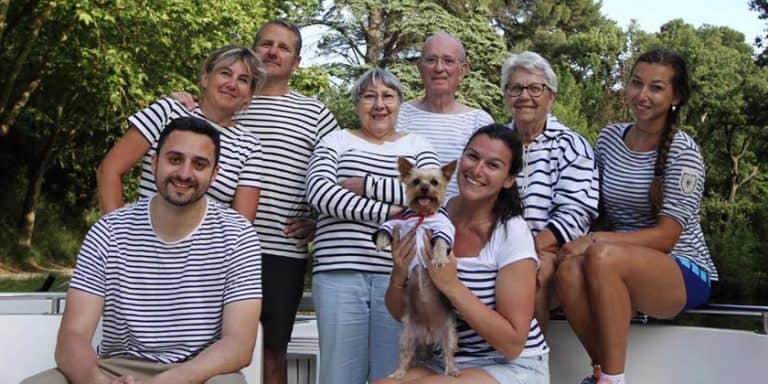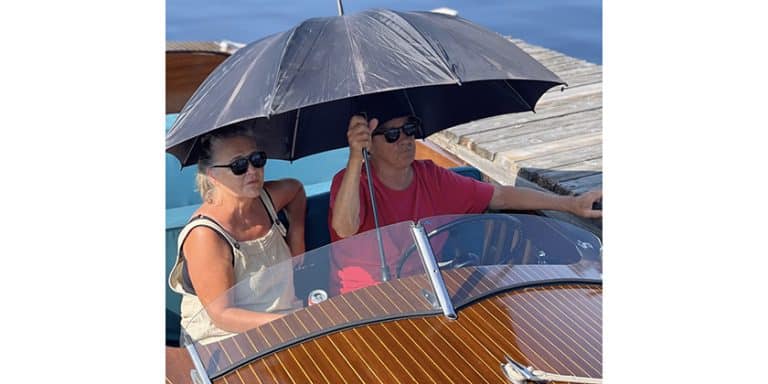Cowichan Bay and Nearby
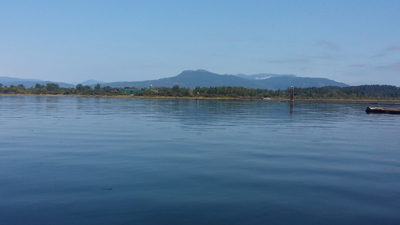
By Catherine Dook
Mount Prevost – taken from Cowichan Bay 1
There is good anchoring in Cowichan Bay and nearby, and salt water enough to make any boater happy. John and I don’t sail our 44-foot s/v Inuksuk anywhere in the Gulf Islands without the appropriate Yeadon-Jones Dreamspeaker cruising guide and it’s all there – holding, depths, currents, and what you can find at your destination, like yards of polypropylene rope at Rick’s Classic Marine in Cowichan Bay, or condoms from Lauren’s Pier 66 Convenience Store. The two are not related.
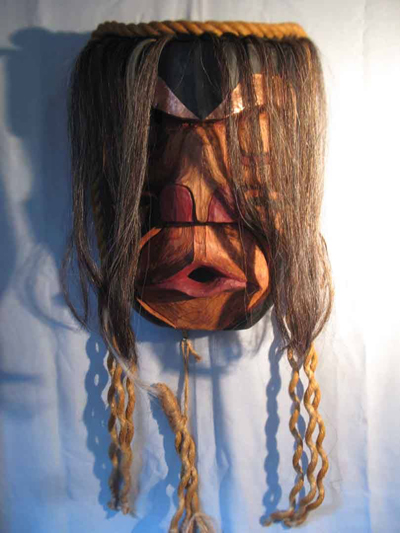 Red Cedar, Horse Hair, Hammered Copper and Hemp Rope, mask and photo by Herb Rice, Coast Salish Artist from the Snuneymuxw First Nation, Nanaimo, BC
Red Cedar, Horse Hair, Hammered Copper and Hemp Rope, mask and photo by Herb Rice, Coast Salish Artist from the Snuneymuxw First Nation, Nanaimo, BC
www.coastsalishjourney.com
But a thousand years ago the Hul’qumi’num speaking people pulled their ocean-going cedar canoes through the same waters without a cruising guide anywhere in sight. The Cowichan First Nations knew the waters from Penelakut Island to the Fraser Delta well because they paddled the route every year. But the landforms, the currents, the rhythms of salmon spawning, were named and understood very differently from British Naval Officers with their gunboats and their compasses and sextants and their habit of naming places after junior officers who retired to dine in the Painted Hall at Greenwich, England.
The Cowichan First Nations understood their world through story – story so powerful that their mythology claims it shaped the landforms. It echoes the Christian story, doesn’t it? “In the beginning was the word, and the word was God.” So the Gospel of St. John tells us.
When the world was born, the Cowichan people say, twelve extraordinary individuals fell from the sky. Syalutsa was the first to show how to encounter the spiritual by bathing in lake and river water, and how to train body and mind to know his place in the world. Listening to his inner voice, Syalutsa built a canoe and braided a long cedar rope, which he tied onto a boulder at the top of Swuqus (Mount Prevost). When the rains came and the land flooded, the canoe rose and the cedar rope stretched to its full length and so Syalutsa did not die. After the rain stopped he sang a song to summon Smuyuqwa’ (ladybug).
“Drink, drink Smuyuqwa’, drink
Your children are flooded
Drink, drink, the bad day, drink…”
And so Smuyuqwa’ drank and the flood waters receded, and the boulder that anchored Syalutsa’s canoe lies still at the top of Mount Prevost. Up another mountain, Tzouhalem (then called Shkewetsen, or ‘Basking in the Sun’), which looms over Cowichan Bay, there is a swelling on the west side. You see, some of the Cowichan people who did not fit into Syalutsa’s canoe fled to Mount Tzouhalem to escape the great flood, and with them came a frog that clung to one side. He is there today. The frog-rock was called Pip’oom, which means ‘little swollen one’.
Down the Cowichan River, should you kayak there during high tide, you will see many rocks. These are people who were changed to stone by Heels, the transformer, who after the twelve people fell from the sky, was sent to bring order to an undisciplined world.
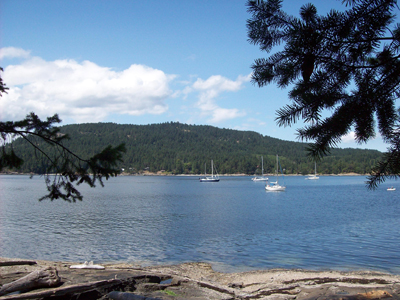 Saltspring Island from Russel Island. The young warrior would have passed here on his way out of Fulford Harbour
Saltspring Island from Russel Island. The young warrior would have passed here on his way out of Fulford Harbour
At Tlulpalus, one man pretended he did not hear the neighbours who warned him to run away from Heels, so as punishment Heels turned him to stone. It is said that even today Cowichan children are warned that if they go near “deaf rock” they will lose their hearing.
Near the mouth of the Cowichan River, Heels transformed into stone a man hurrying up a hill, a woman bathing, and a man watching her. Down the length of the Cowichan River you can see his handiwork: Dogs and people who are now boulders, a thief with a blue cloak who is now a bluejay, Spaal the raven who began as a hunter who did not show Heels courtesy, and Seagull, also once a man, who did.
And when you pull up your anchor and proceed toward Maple Bay, be aware that thrashing in the depths of Sansum Narrows lies an angry sea-monster with a smashed jaw. He is the reason for the currents and whirlpools that knock your vessel sideways in the Narrows. In the early days, the monster Shuh-shu-cum (Open Mouth) laid by Octopus Point and swallowed whole any canoe that passed by. The Elders of the village, worried that they were losing people to this monster who gulped water and canoes, and that nobody could travel safely to Cowichan Bay, conferred with each other, deciding at last to send runners south, west, and north to ask for help.
But one young brave looked east to Point Roberts, where he’d heard of a semi-divine being called Sum-ul-quatz who had extraordinary strength. The young man paddled his ocean-going canoe south from Maple Bay, well around Octopus Point and down Sansum Narrows until he reached Burgoyne Bay, on Saltspring Island. There he pulled his canoe up on the shore and gathered together his provisions, his dried littleneck and butter clams, his dried berries and deer meat. Then he climbed Mount Maxwell (taller and more dangerous then than now) and walked south to Fulford Harbour. There he borrowed a canoe from a friend and paddled between islands, across the Strait of Georgia, and finally to Point Roberts. Exhausted and dismayed, the young man stood in front of Sum-ul-quatz. Filled with compassion for the plight of the Cowichan People, the hero reached down and lifted a giant boulder, which lay at his feet. He unwrapped his sash, and placing the boulder in the sash, he swung it around his head and hurled the boulder across water and islands until it landed in Ladysmith. The second boulder landed inside Active Pass, and the third landed at Paddy’s Point at Maple Bay, where it can still be seen.
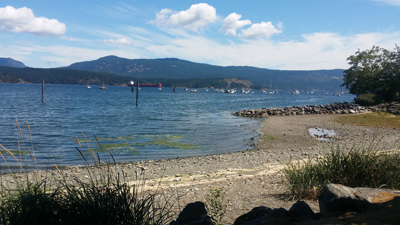 Taken from Hecate Park, Cowihan Bay. Mount Maxwell crouching in the background. 1
Taken from Hecate Park, Cowihan Bay. Mount Maxwell crouching in the background. 1
Having missed three shots, the hero complained Mount Maxwell was blocking his line of sight. He asked the spirit of the mountain to crouch down to help his aim. The spirit of Mount Maxwell was glad to help because positioned as he was on Saltspring Island alongside Sansum Narrows, he had seen many brave men die. The mountain lay on his belly and tucked his head down and when the mighty Sum Ul quatz hurled a fourth stone straight at the monster, he struck him on the snout. Shuh-shu-cum could no longer swallow canoes. He sank to the bottom of the Narrows, where he rages and churns the water to this day.
Thanks to the young warrior canoes could then, with caution, navigate Sansum Narrows. And Mount Maxwell stayed crouched – as you make your way up the Narrows, you can see for yourself.
More recently, some 150 years ago, the mighty warrior Tzouhalem pulled his ocean-going canoe from Penelakut Island to the Fraser Delta as part of his yearly migration. Cantankerous, even murderous, and probably initiated into the Big House flesh-eating ceremony by the grandmother who raised him, Tzouhalem quarrelled with nearly everyone, and in fact was eventually thrown out of his own tribe and exiled to the mountain named after him. But before he hunkered into a cave on the great mountain with his fourteen wives (single women were scarce, so he’d had to kill quite a few husbands to get that number), he was famous for having exchanged fire with the Victoria Hudson Bay Company Fort for two days, over a misunderstanding about who owned some cattle his men shot and then enjoyed beside an open fire. Out of an excess of humanity, the Hudson Bay Company factor, who had the use of nine-inch cannons, ordered the blowing up of a canoe and a building to allow the fiery Tzouhalem to back down before he ordered the cannons turned on people.
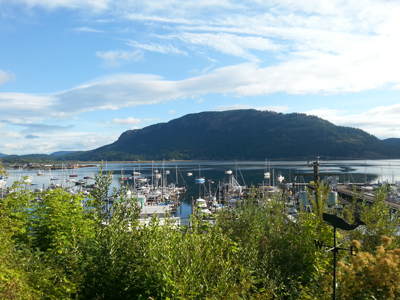 Mount Tzouhelam, which broods over Cowichan Bay
Mount Tzouhelam, which broods over Cowichan Bay
At the northern end of his territory, Tzouhalem once again proved his military cunning in Maple Bay, when warriors from Haida Gwaii swooped south with probably unfriendly intent. Tzouhalem, master of cunning that he was, organized a canoe full of braves to dress as women and paddle across Maple Bay in a leisurely and coquettish manner. The Haida Gwaii had spent many arduous days and lonely nights travelling south from the Queen Charlotte Islands, and a whole canoe full of women, even suspiciously muscular ones, must have been tempting. The northern warriors followed the women, who turned suddenly into fully armed warriors, and Tzouhalem and his men attacked on both flanks. It was a rout.
The end of Tzouhalem’s life is a sad story. He with fourteen wives decided he needed another. Anyone married to fourteen wives doesn’t know anything about women. I speak not as a colonial, but with the authority of womanhood. Polygamous arrangements of any culture usually function well only if none of the women can stand the husband. Anyway, he set his sights on a woman who lived on Penelakut Island, but the attempted kidnapping went awry when the woman’s husband hit him on the head and then decapitated him. The Penelakut First Nations sent the head back to Tzouhalem’s wives, who may or may not have been glad to get it. The headless body may still be on Penelakut Island.
Because the mighty Tzouhalem was brought low by a woman, it seems fitting to end with a Saltspring Island legend about the Wild Woman, a being who would have been known to the crouching Mount Maxwell and the Great Tzouhalem and also Tzouhalem’s grandmother, who taught him to be a warrior.
The Wild Woman, named Quamichan, was a winged flesh-eating giantess who stole hundreds of children and put them into a basket made out of a snake. Quamichan then gathered the children in front of a pile of fire-heated stones in a deep pit. She shrieked that she was going to cook and eat the children and asked her horrified younger sister to smear pitch on the children’s eyes so they could not see what was going to happen to them. Instead the sister smeared the pitch on their eyelids, then she gave each child a dry stick. She flattered the Wild Woman into dancing around the pile of hot stones and as the Wild Woman flew past, shrieking and leaping, the sister tripped her with a stick. The Wild Woman fell on her back into the pit.
“Open your eyes and throw the sticks into the pit,” the sister cried to the children, and when the children did so, the sticks caught fire and burned the Wild Woman, Quamichan. The sparks thrown skyward flew away as ducks and geese, and the children returned home knowing how to make fire.
The places we have visited – Cowichan Bay, Sansum Narrows, Saltspring Island, and Maple Bay – were mapped years before the British arrived with their plumb lines and sextants and rolls of hand-drawn charts.
They were mapped with story. And story is not a bad way of doing it.
For further reading
“Those Who Fell from the Sky” by Daniel P. Marshall, Cultural and Education Centre Cowichan Tribes, 1999.
Wikipedia on ‘Mount Tzouhelam’
“History and Folklore of the Cowichan Indians” Victoria, BC 1904. The Colonist Printing and Publishing Company.
Catherine Dook lives aboard the s/v Inuksuk at Cowichan Bay. Her website is http://catherinedook.com

